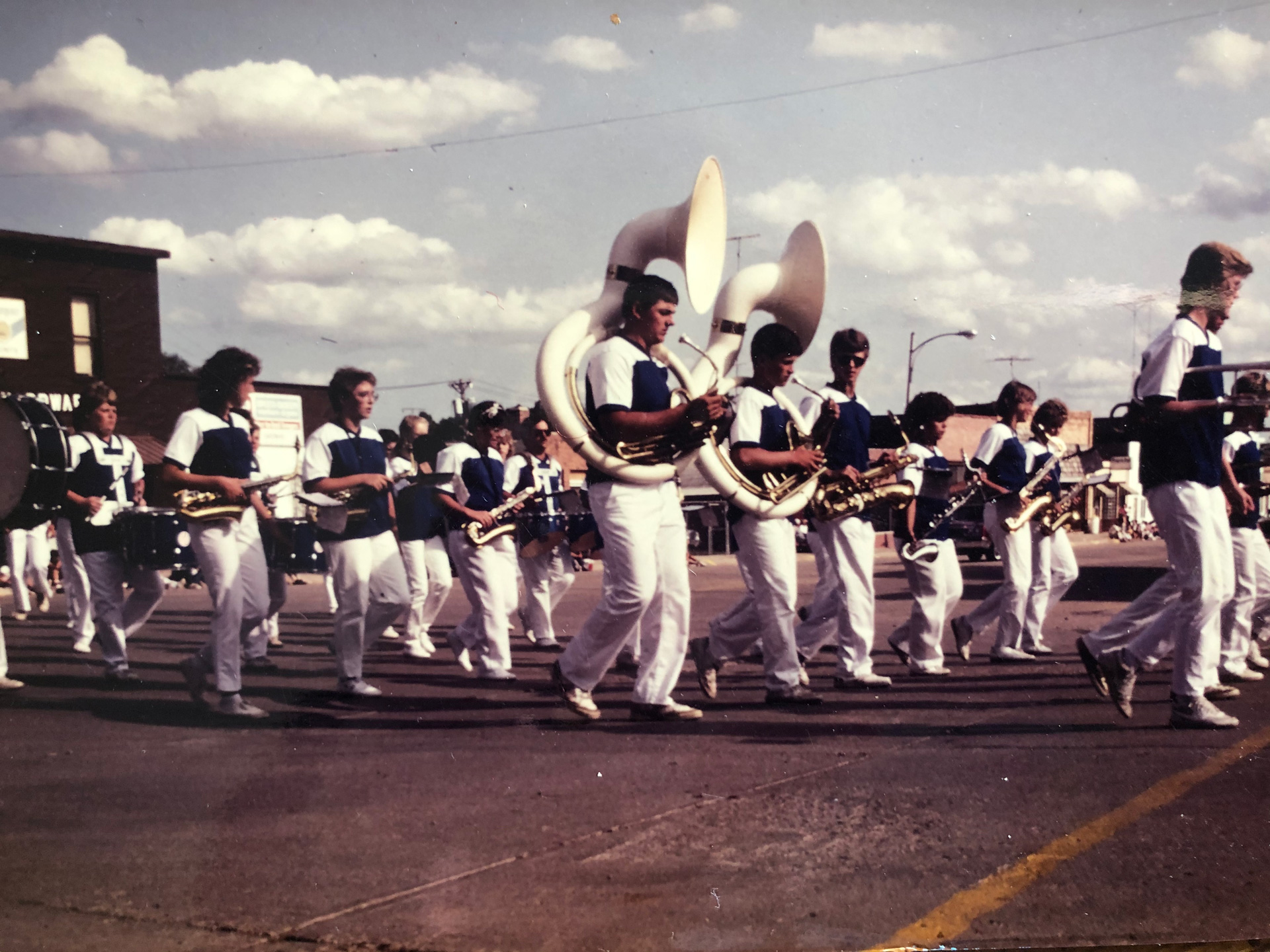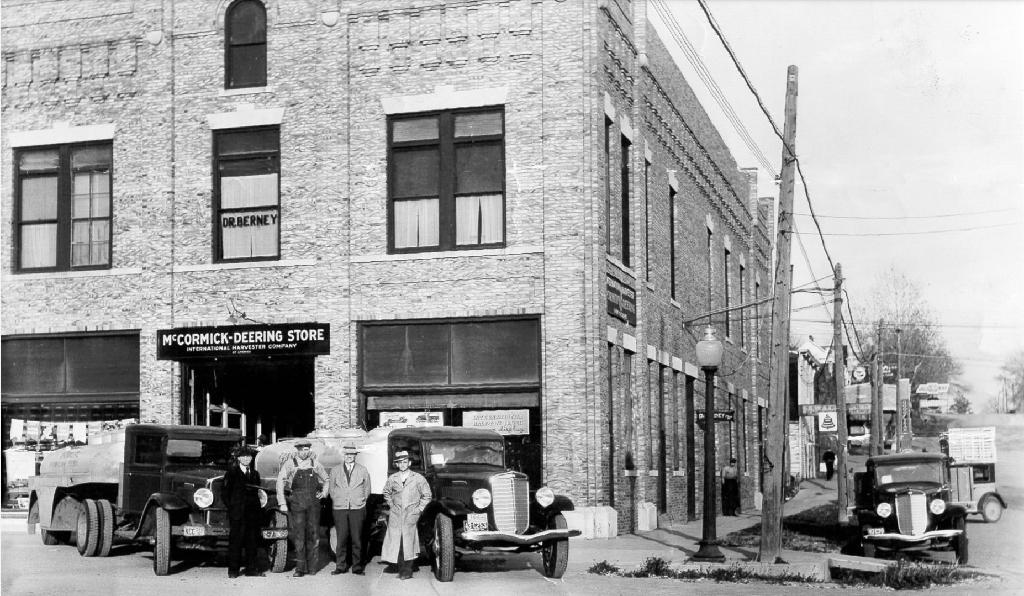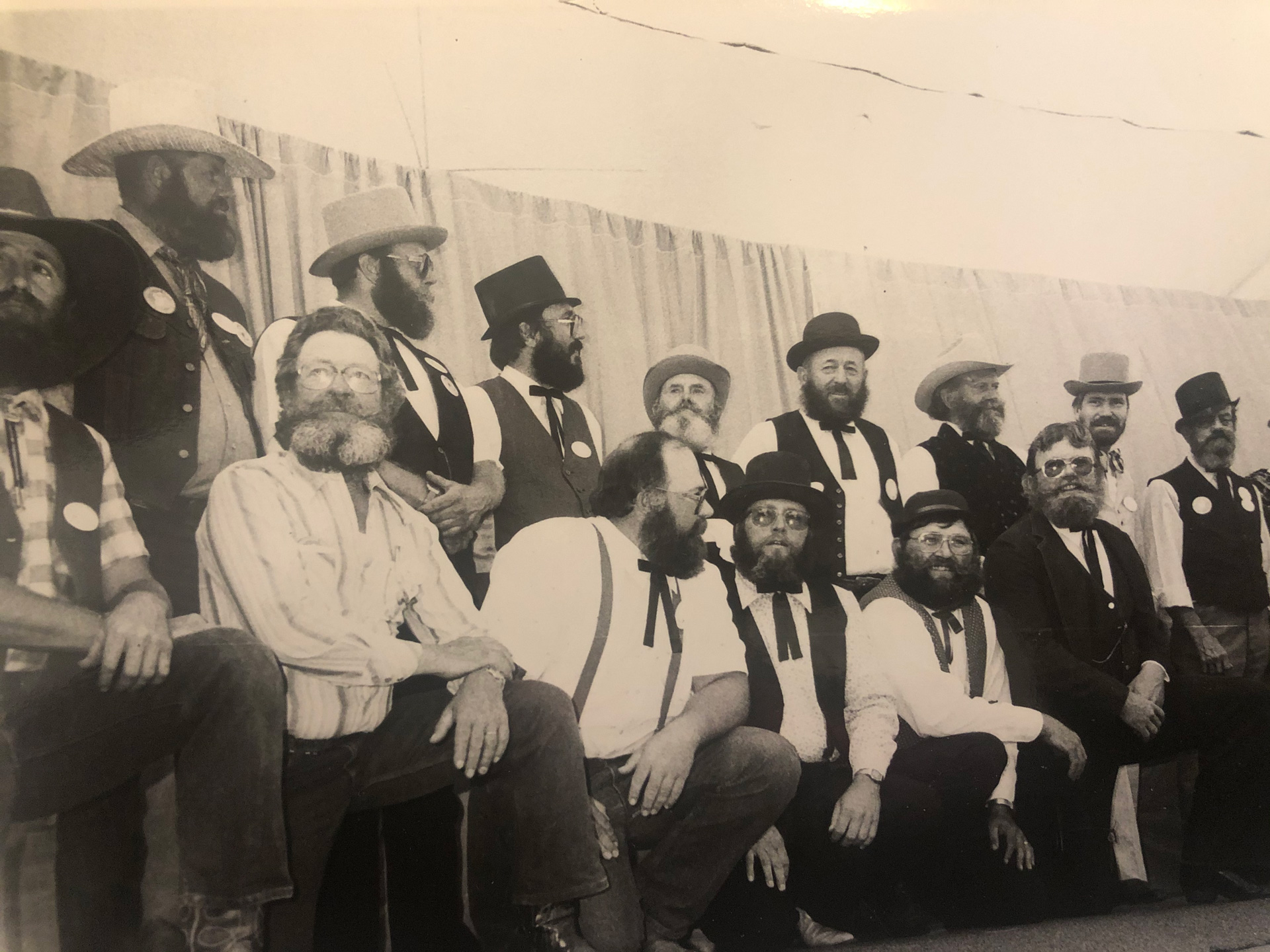Town History
In 1869, the present day Colfax County was separated from Platte County, with county government set up in Schuyler. The first official four families who settled in the Stanton Precinct, Section 18 (the present site of the village of Leigh), were those of Stephen Miller, Ben Valentine, Warren Fusselman, and Jake Woods in 1872. These men were all Civil War veterans who took advantage of the 1865 “free homestead” bill that offered veterans outright grants to quarter-section homesteads in the Midwest as a reward for their service. Many other families soon followed, including the family of A. M. Walling. Also a Civil War veteran, Mr. Walling helped many other families settle on lots south and east of his. The town was named for Mr. Walling’s wife, one of the town’s first postmistresses, her maiden name having been Mary Margaret Leigh.
The first church established in Leigh was the Methodist Church, completed in the fall of 1879 and dedicated in 1880. Soon, many churches were organized in the Leigh community, including St. Paul’s Lutheran Church in 1881, First Congregational Church in 1887, Zion Lutheran Church in 1894, St. Mary’s Catholic Church in 1900, and St. John’s Lutheran Church in 1906.
A branch line of the Fremont, Elkhorn, and Missouri Valley railroad came to town in 1886. The long-awaited coming of the railroad served as a catalyst to the growth of the small village of Leigh. The addition of the railroad changed the center of town in Leigh from the “old town” to the “new town” as businesses relocated to be closer to the railroad. The railroad operated many years before the tracks were torn up in 1963.
On March 7, 1887, the village of Leigh was officially incorporated. At this time, there were 210 residents, churches, and a school. Businesses included the railroad, general merchants, construction contractors, insurance/real estate sales, newspaper, blacksmiths, a physician/surgeon, a dressmaker/milliner, a painter/paperhanger, a harness maker, hardware store, post office, bank, drug store, printing office, farm implement store, meat market, livery and feed stable, city hotel, and saloon.
The first fire department was organized in Leigh in 1907 after the installation of a waterworks system. The first equipment secured was a hand-drawn cart and a hand-drawn hook and ladder wagon. The department was first motorized with the purchase of a 1924 International 4-cylinder truck, and after that a 1929 Model A Ford, which is still in use for parades and celebrations. In 1945, the first pumper truck was bought. In 1978, the Leigh Rural Fire District, with the help of the LVFD and Emergency Unit, erected a new fire barn and meeting room. In 2020, another expansion project added to the current building four additional truck bays, showers and bathroom, as well as a rescue unit office and supply room.
The Colfax County Agricultural Society was established in 1872, and the first fairgrounds were two miles north of Schuyler. Over time, interest in the fair waned, and it was discontinued in Schuyler. A small fair was held on the streets of Leigh in 1921 which affected the reorganization of the Ag Society and the permanent moving of the fair to Leigh in 1922. The Colfax County Fair in Leigh celebrated its 100th Anniversary in 2021.
Leigh has long been a very patriotic community and takes pride in honoring its veterans and active service members. The Sucha Post 302 American Legion received its charter on June 2, 1921, and the American Legion Auxiliary was organized the following year in 1922. The Sons of the American Legion was later established in September 2009.
Official Memorial Day services have been held in Leigh as far back as 1925, and have become a proud annual tradition. Records show that services were held at various locations in the early years, and they are now held at the Leigh High School gym and Leigh cemeteries. The Auxiliary and Sons of the Legion assist the American Legion with the service. For many years there was a procession from city hall to the high school led by the Colors, American Legion members, Auxiliary Colors, and Auxiliary members, followed by elementary school age boys and girls. A program is still held at the high school gym, and a vehicle procession then proceeds to the cemetery where a final graveside service is held. This includes a firing squad, the playing of “Taps” and the national anthem, and a roll call with salute for each serviceman buried in the Leigh cemeteries and elsewhere. As of 2020, a total of 174 Leigh veterans are buried in the Leigh cemeteries, and 63 are buried elsewhere. Nine of these were killed in action. The graves of deceased servicemen, Gold Star Mothers, and Auxiliary members are all decorated each Memorial day.

The Leigh Emergency Unit was organized on October 23, 1968, to provide emergency care and transportation to the sick and injured of the Leigh community. The first emergency unit was a 1967 International Ambulance bought from the Leigh Implement Co. Today, there are always two transport units maintained and operated in active service at all times. In 2020, an expansion project to the current fire and rescue barn added an additional four truck bays, showers and bathroom, as well as a rescue unit office and supply room.
On July 13, 1975, the House of Yesteryear Museum was dedicated and formally opened to the public. The House of Yesteryear was built in 1875 and was the first general store and post office in Leigh. The Frank Smith family purchased it in 1884 and continued to operate the grocery store in the building until the new railroad depot moved the center of town several blocks west. The building remained the home of the Smiths and then of their daughter, Mrs. Mary Overstreet, throughout her life. For many years, the large room above the store was furnished as a Grand Army of the Republic Hall and served as the meeting place for American Legion and Auxiliary societies.
At the time of Mrs. Overstreet’s death in 1971 at age 103, her son, Roy Overstreet, gave the historic building to the Village of Leigh. The 11-room museum, restored to represent a late 19th century home, features a veteran’s room, toy room, sewing room, and library. Outside are a barn, outhouse, and coal shed. A variety of Leigh organizations and churches sponsored the upkeep of individual rooms through the years, and many individuals and groups from throughout the United States have visited the house since its inauguration.
Many celebration events were held in the year leading up to the final Centennial celebration, including the performance of the homespun drama “Leigh…Through the Pages of Time.” Over 300 current and former community members, young and old, participated in the cast and crew of this play, directed by Norma Fuhr and the Leigh Playmakers, which drew a packed house of over 600 audience members in its two-night run in May 1987.
Leigh celebrated its Centennial Anniversary June 26-28, 1987. The three-day celebration included an opening ceremony, Centennial-period costume and beard contest, heritage program, community barbecue, trail ride, various music performances (Keynoters community singing group, community band, community barbershop octet, and community choir), Keystone Cops, community church and Sunday School, community run, all-class reunion, lip sync contest, horseshoe contest, carnival, quilt show, various centennial displays, various dances and concerts, parade, time capsule, closing ceremonies, and more.
Over 1000 people, including Senator Ben Nelson, attended the grand opening of the Maple Creek Recreation Area in Leigh on May 21, 2011. The Maple Creek Dam was the result of ten years of planning and provides flood protection for the village of Leigh as well as property and land owners on the west fork of Maple Creek. The lake created by the dam is 160 acres, which are split in two parts by Highway 91. The entire recreation area covers 550 acres and includes 50 RV camping sites, trails for walking or horseback riding, picnic areas, showers and restrooms, and opportunities for hunting. The $8.2 million project was funded by the Lower Elkhorn Natural Resources District in collaboration with the Nebraska Department of Natural Resources, the Nebraska Department of Roads, and the Nebraska Game and Parks Commission.
School History
In 1874, the first public school, known as School District No. 39, was opened to the children of the first families who homesteaded in Section 18. The original school was a one-room, 18 x 24 ft frame structure erected under the direction of one of Leigh’s first homesteaders, Ben Valentine. The first school included 9 students, 4 rows of seats, a limited number of books, one large dictionary, and a globe. The first class graduated in 1881, consisting of two pupils: Guy Walling and Grant Smith.
Due to increased enrollment, a two-story, four-room frame school building was built, and the staff was increased to one principal and two teachers in 1888.
A special election bond in 1907 approved $15,750 to build and equip a new eight-room school. It was this building, along with future additions, which served the district until 2020.
A furnace room fire did extensive damage to the school in January 1925. Due to a rapid increase in student enrollment, the school board decided to not only remodel the entire structure, but to also build an addition to the north. The remodel cost $14,500, and the new addition cost $20,000. The addition included a high school assembly, gymnasium, and two recitation rooms.
A school bond issue was passed in 1951, authorizing $165,000 to build a new addition to the school building that included a larger gym, stage, shop, and music room.
In 1966, Leigh Schools enrollment increased after the reorganization or closure of many small rural schools in Colfax, Platte, and Stanton County, including:
- District 37 (Lonely Valley School – 3½ miles north of Creston)
- District 40 (2 ½ miles southeast of Leigh)
- District 42 (Macedonia School – 3 miles east and ½ mile north of Leigh)
- District 23 (Goldenrod School – 6½ miles southwest of Leigh)
- District 78 (1 mile east, 1 mile north of Creston)
- District 43 (Rosebud School – 3½ miles southwest of Leigh)
- District 45 (3 miles southeast of Creston)
Due to increased elementary enrollment, the Leigh elementary school grades were moved to a separate building in the 1968-69 school year. The school district purchased the Memorial Auditorium from the American Legion at a cost of $2,500. The auditorium was built in 1948 and used to hold dances and other community events. In 1967, it was converted into 6 classrooms, an office, multipurpose room, and library. This building and additions to it served as the district elementary school until 1999.
In 1999, Leigh Community Schools dedicated a new, brick elementary school, which was constructed after a successful bond issue. The Leigh superintendent at the time was Cecil Fields.
For many years, the school districts of Leigh and Clarkson have shared a special relationship, sharing teachers and academic programs as far back as the late 90s. In 2012, due to reduced student enrollment, Leigh and Clarkson united together to give students in both schools more extracurricular opportunities while still allowing each to maintain their individual school and community identities. Thus, the Clarkson-Leigh Patriot co-op was born.
The co-op began in a small way, with volleyball, track, and junior high sports teams combining in 2011-12. The next school year, Leigh and Clarkson joined football, boys’ and girls’ basketball, golf, and dance. In 2014, they also combined with Howells-Dodge to form the Highway 91 Cyclone softball team, adding a new sport for students to be involved in. In the 2016-17 school year, a Patriot wrestling team was formed, marking the first time in decades either school had offered wrestling.
A combined Patriot Booster Club and thriving youth athletic programs have greatly helped bolster the success of the Patriot name. The success of the coop is the result of the hard work, communication, and compromise of the students, staff, administrations, and parents at both schools.
In 2020, Leigh Community Schools dedicated a new, brick addition to the current elementary school after a nearly $10 million bond issue passed overwhelmingly. The new addition serves as a high school.


